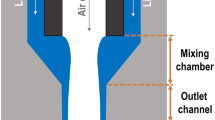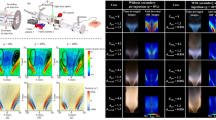Abstract
In this numerical study, an algebraic flame surface wrinkling (AFSW) reaction submodel based on the progress variable approach is implemented in the large-eddy simulation (LES) context and validated against the triangular stabilized bluff body flame configuration measurements i.e. in VOLVO test rig. The quantitative predictability of the AFSW model is analyzed in comparison with another well validated turbulent flame speed closure (TFC) combustion model in order to help assess the behaviour of the present model and to further help improve the understanding of the flow and flame dynamics. Characterization of non-reacting (or cold) and reacting flows are performed using various subgrid scale models for consistent grid size variation with 300,000 (coarse), 1.2 million (intermediate) and 2.4 million (fine) grid cells. For non-reacting flows at inlet velocity of 17 m/s and inlet temperature 288 K, coarse grid leads to over prediction of turbulence quantities due to low dissipation at the early stage of flow development behind the bluff body that convects downstream eventually polluting the resulting solution. The simulated results with the intermediate (and fine) grid for mean flow and turbulence quantities, and the vortex shedding frequency (fs) closely match experimental data. For combusting flows for lean propane/air mixtures at 35 m/s and 600 K, the vortex shedding frequency increase threefold compared with cold scenario. The predicted results of mean, rms velocities and reaction progress variable are generally in good agreement with experimental data. For the coarse grid the combustion predictions show a shorter recirculation region due to higher turbulent burning rate. Finally, both cold and reacting LES data are analyzed for uncertainty in the solution using two quality assessment techniques: two-grid estimator by Celik, and model and grid variation by Klein. For both approaches, the resolved turbulent kinetic energy is used to estimate the grid quality and error assessment. The quality assessment reveals that the cold flows are well resolved even on the intermediate mesh, while for the reacting flows even the fine mesh is locally not sufficient in the flamelet region. The Klein approach estimates that depending on the recirculation region in cold scenario both numerical and model errors rise near the bluff-body region, while in combusting flows these errors are significant behind the stabilizing point due to preheating of unburned mixture and reaction heat release. The total error mainly depends on the numerical error and the influence of model error is low for this configuration.
Similar content being viewed by others
References
Spalding, D.B.: Development of the Eddy-break-up model of turbulent combustion. Proc. Combust. Inst. 16, 1657–1663 (1976)
Magnussen, B.F., Hjertager, B.H.: On mathematical modeling of turbulent combustion with special emphasis on soot formation and combustion. Proc. Combust. Inst. 16, 719–729 (1976)
Zimont, V.L., Lipatnikov, A.N.: A numerical model of premixed turbulent combustion of gases. Chem. Phys. Rep. 14(7), 993–1025 (1995)
Poinsot, T., Veynante, D., Candel, S.: Diagrams of premixed turbulent combustion based on direct simulation. Proc. Combust. Inst. 23, 613–619 (1990)
Peters, N.: A spectral closure for premixed turbulent combustion in the flamelet regime. J. Fluid Mech. 242, 611–629 (1992)
Muppala, S.P.R., et al.: Development of an algebraic reaction rate closure for the numerical calculation of turbulent premixed methane, ethylene and propane/air flames for pressures up to 1.0 MPa. Combust. Flame 140, 257–266 (2005)
Aluri, N.K., Muppala, S.P.R., Dinkelacker, F.: Large-Eddy simulation of lean premixed turbulent flames of three different combustion configurations using a novel reaction closure. Flow Turbul. Combust. 80, 207 (2008)
Smagorinsky, J.: General circulation experiments with the primitive equations. I. The basic experiment. Mon. Weather Rev. 91, 99–164 (1963)
Yoshizawa, A., Horiuchi, K.: A statistically-derived subgrid-scale kinetic energy model for the large eddy simulation of turbulent flows. J. Phys. Soc. Japan 54, 2834–2839 (1985)
Germano, M., et al.: Dynamic subgrid-scale Eddy viscosity model. Summer Workshop, Centre for Turbulence Research, Stanford, CA (1996)
Möller, P., Lundgren, E., Fureby, C.: Large eddy simulation of unsteady combustion. Proc. Combust. Inst. 26, 241–248 (1996)
Kim, S.H., Huh, K.Y., Tao, L.: Application of the elliptic conditional moment closure model to a two-dimensional nonpremixed methanol bluff-body flame. Combust. Flame 120(1–2), 75–90 (1999)
Weller, H.G., et al.: Application of a flame-wrinkling LES combustion model to a turbulent mixing layer. Proc. Combust. Inst. 27, 899–907 (1998)
Angelberger, C., et al.: Large eddy simulation of combustion instabilities in turbulent premixed flames. In: Center for Turbulence Research, Proceedings of the Summer Program 1998. Stanford (1998)
Poinsot, T., Veynante, D.: Theoretical and Numerical Combustion. Edwards, Philadelphia (2001)
Flohr, P., Pitsch, H.: A turbulent flame speed closure model for LES of industrial burner flows. In: Center for Turbulence Research, Proceedings of the Summer Program 2000. Stanford (2000)
Celik, I., Cehreli, Z.N., Yavuz, I.: Index of resolution quality for large eddy simulations. Journal of Fluids Engineering 127(Sep), 949–958 (2005)
Celik, I., Klein, M., Janicka, J.: A test of validation of turbulent premixed models for high-pressure Bunsen flames. In: Proceedings of FEDSM2006, ASME Joint U.S. European Fluids Engineering Summer Meeting, July 17–20. Miami Florida (2006)
Klein, M.: An attempt to assess the quality of large eddy simulations in the context of implicit filtering. Flow Turbul. Combust. 75, 131–147 (2005)
Geurts, B.J., Fröhlich, J.: A framework for predicting accuracy limitations in large eddy simulation. Phys. Fluids 14, L41–L44 (2002)
Meneveau, C.: Issues and case studies for experimental validation of LES in incompressible flows. In: Janicka, J., et al. (eds.) Proceedings of the Conference on Quality Assessment of Unsteady Methods for Turbulent Combustion Prediction and Validation. CD issued by Department of Energy and Powerplant Technology Tech. Univ. of Darmstadt, Germany (2005)
Pope, S.B.: Turbulent Flows. Cambridge University Press, Cambridge (UK) (2000)
Meyers, J., Geurts, B.J., Sagaut, P.: A computational error-assessment of central finite-volume discretisation in large-eddy simulation using a Smagorinsky model. J. Comput. Phys. 19(9), 2740–2755 (2007)
Kempf, A., et al.: Large-eddy simulation of a counterflow configuration with and without combustion. Proc. Combust. Inst. 28, 35–40 (2000)
Kempf, A., Sadiki, A., Janicka, J.: Prediction of finite chemistry effects using large eddy simulation. Proc. Combust. Inst. 29, 1979 (2002)
Veynante, D., Vervisch, L.: Turbulent combustion modeling. Prog. Energy Combust. Sci. 28, 193–266 (2002)
Sagaut, P.: Large eddy simulation of incompressible flows, 3rd edn. Springer, Heidelberg (2006)
Fluent: Computational Fluid Dynamics Software. Fluent Incorporated, Lebanon, NH, USA (2005)
Sjunneson, A., Henriksson, P., Löfström, C.: Cars measurements and visualization of reacting flows in a bluff body stabilized flames. AIAA 92, 3650 (1992)
Fureby, C., Möller, S.-I.: Large Eddy simulation of reacting flows applied to bluff body stabilized flames. AIAA J. 33(12), 2339–2347 (1995)
Zhang, X., Perot, B.B.: Turbulent vortex shedding from triangualr cylinder using the turbulent body force potential model. In: Proceedings of FEDSM2000, ASME Fluids Engineering Divison Summer Meeting, Massachusetts, June 11–15 (2000)
Giacomazzi, E., Battaglia, V., Bruno, C.: The coupling of turbulence and chemistry in a premixed bluff-body flame as studied by LES. Combust. Flame 138(4), 320–335 (2004)
Porumbel, I.: Large Eddy Simulation of Bluff Body Stabilized Premixed and Partially Premixed Combustion. School of Aerospace Engineering, Georgia Institute of Technology (2006)
Dinkelacker, F., Bhuvaneswaran, M., Muppala, S.P.R.: Modelling and simulation of lean premixed turbulent methane/hydrogen/air flames with an effective Lewis number approach. Combust. Flame 158, 1742–1749 (2011)
Bradley, D., et al.: Turbulent burning velocity, burned gas distribution, and associated flame surface definition. Combust. Flame 133(4), 415–430 (2003)
Boudier, G., et al.: Effect of mesh resolution on large eddy simulation of reacting flows in complex geometry combustors. Combust. Flame 155, 196–214 (2009)
Author information
Authors and Affiliations
Corresponding author
Rights and permissions
About this article
Cite this article
Manickam, B., Franke, J., Muppala, S.P.R. et al. Large-eddy Simulation of Triangular-stabilized Lean Premixed Turbulent Flames: Quality and Error Assessment. Flow Turbulence Combust 88, 563–596 (2012). https://doi.org/10.1007/s10494-011-9385-5
Received:
Accepted:
Published:
Issue Date:
DOI: https://doi.org/10.1007/s10494-011-9385-5




